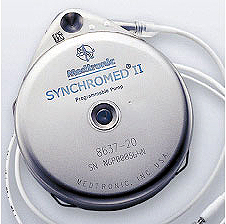 What is an implantable drug infusion pump?
What is an implantable drug infusion pump?
As opposed to drugs delivered by different routes of administration to systematic circulation, the implantable pump delivers drastic drugs through an implanted catheter straight into the fluid surrounding the spinal cord. This mode of drug administration achieves more effective analgesia with fewer and more tolerable drug side-effects.
Information about the implantable drug infusion system
The system consists of a pump and catheter, which are surgically implanted under the skin. The pump is a round device with a drug storage tank and software that electronically delivers the drug in the desirable dose. The pump is placed in the lateral abdominal area, between the costal arch and iliac crest. The thin and flexible catheter is inserted into the subarachnoid space of the spine containing cerebrospinal fluid (CSF = the fluid surrounding the spinal cord) and is connected transdermally with the pump.
The pump is filled with the drug during surgery with the use of a syringe. The pump delivers the drug dose that has been pre-programmed by the physician and reaches CSF through the catheter.
The pump tank is refilled with drug very easily at the physician’s office by inserting a fine needle into the pump transdermally through a special entry port.
 Programming of the drug infusion system
Programming of the drug infusion system
The system is composed of:
• Programmable electronic pump. The pump has a battery and is electronically programmed by the physician with the use of an external programming control device and a sensor above the area where the pump has been implanted.
• Programming control device for the therapist physician. A portable device with which the physician programs every single detail related to the pump and receives information concerning the therapy (patient’s involvement in delivering pre-programmed doses, volume of the remaining drug in the pump and expected refilling day).
• Programming control device for the patient. A small device with which the patient receives the information needed about the refilling day and remaining drug volume in the pump. The patient has the potential to self-deliver additional doses (pre-programmed by the physician) for treating paroxysmal pain.
Drugs approved by FDA (Food and Drug Administration)
• Μorphine (opioid, pain treatment)
• Ζiconotide (non-opioid, pain treatment)
• Baclofen (treatment of resistant spasticity)
Advantages of therapy
• Before the infusion system is finally implanted, a temporary testing drug infusion is made –either with an external pump or with one single delivery. Then, the result of the specific therapeutic technique along with the patient’s degree of satisfaction are evaluated .
Should the patient be dissatisfied with the therapy outcome, the catheter is simply withdrawn and another pain treatment is selected.
• The drug is delivered straight into the CSF, limits adverse events and provides more effective and qualitative analgesia with far much smaller doses compared to other routes of drug administration (orally, subcutaneously, intravenously etc).












